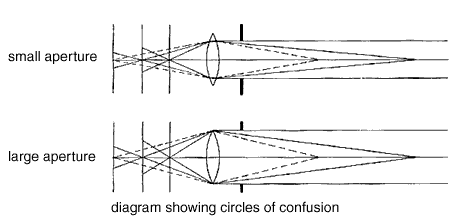
Depth of Field - A Short Introduction by Christopher John Ball

Tweet
When one focuses a camera upon a subject, to give a sharp image, objects nearer to the lens, and those further away from it, do not appear equally sharp. This decline in sharpness is gradual and progressive.
There exists an area of apparent focus, both behind and in front of the subject, where the blur is too small to be noticeable and therefore appears sharp. This area, between the furthest and nearest parts of a subject that be photographed with acceptable sharpness, is known as the ' depth of field '.
The level of blur that the viewer is prepared to accept as sharp depends upon the ' circle of confusion '.
As can be seen in the above image - the 'circle of confusion' is formed on the focal plane as points. These points vary in size as the aperture is altered and this results in the depth of field varying accordingly.
In addition to the aperture - 'depth of field' also depends upon the focal length of the lens and the distance from the lens to the subject. The shorter the focal length of the lens, and the smaller the aperture, the greater the depth of field. As the subject is placed nearer to the camera lens this depth of field decreases for any given lens/aperture combination.
Almost all lens have a depth of field scale on the barrel. You can use this to work out the amount of depth of field available for any given aperture on the lens you are using. If you study this scale you will note that there is greater depth of field behind the subject than there is before the object photographed.
This is approximately split 1/3 in front of the subject and 2/3 behind.
The aperture markings away from the infinity setting of the lens, on the of the scale, represent the depth of field in front of the subject, whilst those that point to towards the infinity setting represent that field that lies behind the subject.
To use this scale first focus your lens upon the main subject you wish to photograph. Then make an exposure reading and a select an aperture. Having done this it is possible, by referring to the depth of field markings on the lens, to gauge the range of depth of field available by reading the f-number you are using off the left and right sections of the scale.
The greatest depth of field is produced when :
The smallest depth of field is produced when :
- The f - number is high, i.e. a small aperture.
- The subject is distant, i.e. furthest from the lens.
- The focal length of the lens you are using is short, i.e. a wide angle lens.
- The f - number is low, i.e. a large aperture.
- The subject is near, i.e. nearest the lens.
- The focal length of the lens you are using is long, i.e. a telephoto lens.
Therefore you will find that the available depth of field will be less when you are shooting 'close - ups' or if you are using a long focus lens - even if you are using the same aperture on all lens.
You can use depth of field creatively within your photography. By choosing a narrow depth of field a subject can be isolated from a distracting background. This is called differential focusing. Conversely you can choose a wide depth of field to make all elements of an image sharp to create depth and generate maximum detail/information.
Not to be confused with depth of focus. The difference being that depth of field is the range that the subject can be moved and still be in apparent focus. Depth of focus being the range that the film can be moved within the film plane and still appear sharp.July 2024 Several books, featuring Christopher John Ball's photographs, are now available through Amazon or click on an image below to purchase via secure payments on lulu.com

Tweet










